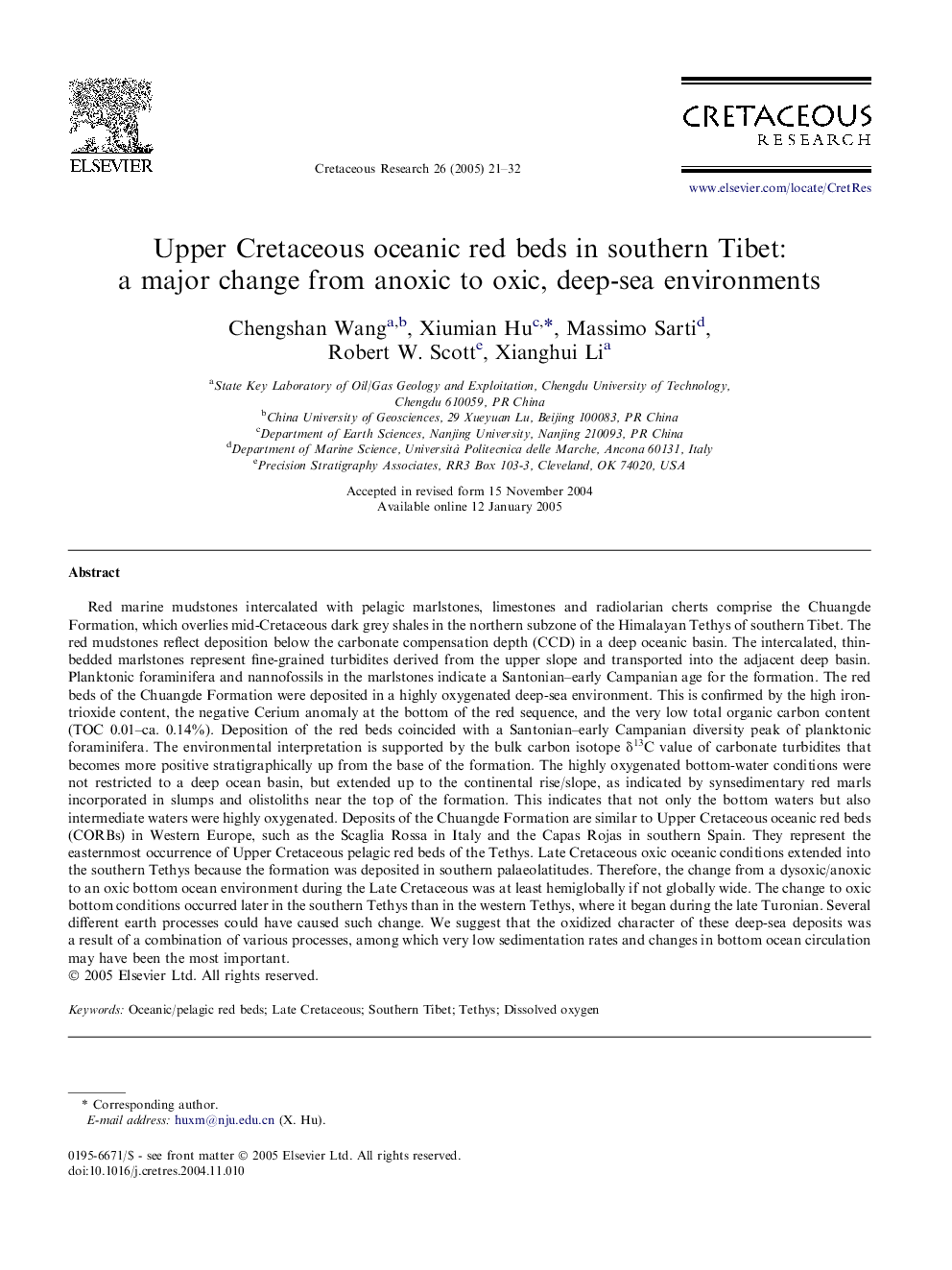| کد مقاله | کد نشریه | سال انتشار | مقاله انگلیسی | نسخه تمام متن |
|---|---|---|---|---|
| 9538986 | 1359955 | 2005 | 12 صفحه PDF | دانلود رایگان |
عنوان انگلیسی مقاله ISI
Upper Cretaceous oceanic red beds in southern Tibet: a major change from anoxic to oxic, deep-sea environments
دانلود مقاله + سفارش ترجمه
دانلود مقاله ISI انگلیسی
رایگان برای ایرانیان
کلمات کلیدی
موضوعات مرتبط
مهندسی و علوم پایه
علوم زمین و سیارات
فسیل شناسی
پیش نمایش صفحه اول مقاله

چکیده انگلیسی
Red marine mudstones intercalated with pelagic marlstones, limestones and radiolarian cherts comprise the Chuangde Formation, which overlies mid-Cretaceous dark grey shales in the northern subzone of the Himalayan Tethys of southern Tibet. The red mudstones reflect deposition below the carbonate compensation depth (CCD) in a deep oceanic basin. The intercalated, thin-bedded marlstones represent fine-grained turbidites derived from the upper slope and transported into the adjacent deep basin. Planktonic foraminifera and nannofossils in the marlstones indicate a Santonian-early Campanian age for the formation. The red beds of the Chuangde Formation were deposited in a highly oxygenated deep-sea environment. This is confirmed by the high iron-trioxide content, the negative Cerium anomaly at the bottom of the red sequence, and the very low total organic carbon content (TOC 0.01-ca. 0.14%). Deposition of the red beds coincided with a Santonian-early Campanian diversity peak of planktonic foraminifera. The environmental interpretation is supported by the bulk carbon isotope δ13C value of carbonate turbidites that becomes more positive stratigraphically up from the base of the formation. The highly oxygenated bottom-water conditions were not restricted to a deep ocean basin, but extended up to the continental rise/slope, as indicated by synsedimentary red marls incorporated in slumps and olistoliths near the top of the formation. This indicates that not only the bottom waters but also intermediate waters were highly oxygenated. Deposits of the Chuangde Formation are similar to Upper Cretaceous oceanic red beds (CORBs) in Western Europe, such as the Scaglia Rossa in Italy and the Capas Rojas in southern Spain. They represent the easternmost occurrence of Upper Cretaceous pelagic red beds of the Tethys. Late Cretaceous oxic oceanic conditions extended into the southern Tethys because the formation was deposited in southern palaeolatitudes. Therefore, the change from a dysoxic/anoxic to an oxic bottom ocean environment during the Late Cretaceous was at least hemiglobally if not globally wide. The change to oxic bottom conditions occurred later in the southern Tethys than in the western Tethys, where it began during the late Turonian. Several different earth processes could have caused such change. We suggest that the oxidized character of these deep-sea deposits was a result of a combination of various processes, among which very low sedimentation rates and changes in bottom ocean circulation may have been the most important.
ناشر
Database: Elsevier - ScienceDirect (ساینس دایرکت)
Journal: Cretaceous Research - Volume 26, Issue 1, February 2005, Pages 21-32
Journal: Cretaceous Research - Volume 26, Issue 1, February 2005, Pages 21-32
نویسندگان
Chengshan Wang, Xiumian Hu, Massimo Sarti, Robert W. Scott, Xianghui Li,